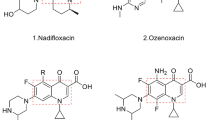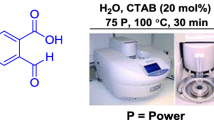Abstract
This report focuses on the synthesis of 2-phenyl-7-substitutedquinoline-4-carboxylic acid derivatives through both conventional and microwave-irradiated methods. Intermediate 7-chloro-2-phenyl-quinoline-4-carboxylic acid was synthesized by condensation and cyclization of benzaldehyde, pyruvic acid, and m-chloroaniline in the presence of absolute ethanol and further substituted with aromatic, aliphatic, and alicyclic amines to obtain the desired 2-phenyl-7-substitutedaryl/alkylamino-quinoline-4-carboxylic acid derivatives under the influence of microwave irradiation, with output power ranging from 160 to 480 W, yield ranging from 90% to 95%, and a shorter reaction time than with the conventional method. All the synthesized compounds were screened for in vitro antimicrobial activity against six gram-positive and four gram-negative organisms. All synthesized compounds are active against a broad spectrum of microorganisms, with prominent results for Streptococcus pyrogenes and Pseudomonas aeruginosa. Compounds 7c and 7h showed a minimum inhibitory concentration of less than 10 μg.

Similar content being viewed by others
References
Atwell GJ, Baguley BC, Denny WA (1989) Potential antitumor agents: “minimal” DNA-intercelating ligands as antitumor drugs: phenylquinoline-8-carboxamides. J Med Chem 32:396–401. doi:10.1021/jm00122a018
Batt DG, Petraitis JJ, Sherk SR (1996) 2-carbocyclic and 2-heterocyclic quinoline-4-carboxylic acids and salts thereof useful as immunosuppressive agents. The DuPont Merck Pharmaceuticals Company, Wilmington, Del. U.S. Patent 5,578,609
Belenkaya RS, Boreko EI, Zemtsova MN, Kalinina MI, Timofeeva MM, Trakhtenberg PL, Chelnov VM, Lipkin AE, Votyakov VI (1981) Synthesis and antiviral activity of 2-[aryl(hetaryl)]quinoline-4-carboxylic acids. Pharm Chem J 15:171–176. doi:10.1007/BF00758458
Bose AK, Manhas MS, Ghosh M, Raju VS, Tabei K, Urbancyk-Lipkowska Z (1990) Highly accelerated reactions in a microwave oven: synthesis of heterocycles. Heterocycles 30:741–744. doi:10.3987/COM-89-S42
Bose AK, Manhas MS, Ghosh M, Raju VS, Bari SS, Newaz SN, Banik BK, Choudhary AG, Barakat KJ (1991) Microwave-induced organic reaction enhancement chemistry. 2. Simplified techniques. J Org Chem 56:6968–6970. doi:10.1021/jo00025a004
Butler MM, LaMarr WA, Foster KA, Barnes MH, Skow DJ, Lyden PT, Kustigian LM, Zhi C, Brown NC, Wright GE, Bowlin TL (2007) Antibacterial activity and mechanism of action of a novel anilinouracil-fluoroquinolone hybrid compound. Antimicrob Agents Chemother 51:119–127. doi:10.1128/AAC.01311-05
Carling WR, Elliott JM, Mezzogori E, Russell MGN, Williams BJ (2006) Quinoline derivatives as neurokinin receptor antagonists. Merck Sharp & Dohme Limited, Hoddesdon, Hertfordshire. WO/2006/013393
Dinakaran M, Senthilkumar P, Yogeeswari P, China A, Nagaraja V, Sriram D (2008) Synthesis, antimycobacterial activities, and phototoxic evaluation of 5 h-thiazolo[3,2-α]quinoline-4-carboxylic acid derivatives. Med Chem 4:482–491. doi:10.2174/157340608785700225
Duvelleroy D, Perrio C, Pariselc O, Lasne MC (2005) Rapid synthesis of quinoline-4-carboxylic acid derivatives from arylimines and 2-substituted acrylates or acrylamides under indium(III) chloride and microwave activations: scope and limitations of the reaction. Org Biomol Chem 3:3794–3804. doi:10.1039/b509400c
Goksu S, Uguz MT, Ozdemir H, Secen H (2005) A concise synthesis and the antibacterial activity of 5,6-dimethoxynaphthalene-2-carboxylic acid. Turk J Chem 29:199–205
Gualtieri F, Tsakotellis P, Skinner W, Johnson H, Skidmore D, Maibach H (1973) Topical mosquito repellents: VI. Sulfonamides and quinoline-4-carboxylic acid derivatives. J Pharm Sci 62:849–851. doi:10.1002/jps.2600620543
Ivachtchenko AV, Khvat AV, Kobak VV, Kysil VM, Williams CT (2004) A new insight into the Pfitzinger reaction: a facile synthesis of 6-sulfamoylquinoline-4-carboxylic acids. Tetra Lett 45:5473–5476. doi:10.1016/j.tetlet.2004.05.028
Koga H, Itoh A, Murayama S, Suzue S, Irikura T (1980) Structure–activity relationships of antibacterial 6,7- and 7,8-disubstituted 1-alkyl-1,4-dihydro-4-oxoquinoline-3-carboxylic acids. J Med Chem 23:1358–1363. doi:10.1021/jm00186a014
Metwally KA, Abdel-Aziz LM, Lashine el SM, Husseiny MI, Badawy RH (2006) Hydrazones of 2-aryl-quinoline-4-carboxylic acid hydrazides: synthesis and preliminary evaluation as antimicrobial agents. Bioorg Med Chem 14:8675–8682. doi:10.1016/j.bmc.2006.08.022
Mitra AK, De A, Karchaudhuri N (1999) Application of microwave irradiation techniques for the synthesis of cinnamic acids by doebner condensation. Synth Commun 29:573–581. doi:10.1080/00397919908085805
Musiol R, Jampilek J, Kralova K, Richardson DR, Kalinowski D, Podeszwa B, Finster J, Niedbala H, Palka A, Polanski J (2007) Investigating biological activity spectrum for novel quinoline analogues. Bioorg Med Chem 15:1280–1288. doi:10.1016/j.bmc.2006.11.020
Strigacova J, Hudecova D, Varecka L, Lasikova A, Vegh D (2000) Some biological properties of new quinoline-4-carboxylic acid and quinoline-4-carboxamide derivatives. Folia Microbiol (Praha) 45:305–309. doi:10.1007/BF02817551
Tu S, Zhu X, Zhang J, Xu J, Zhang Y, Wang Q, Jia R, Jiang B, Zhang J, Yao C (2006) New potential biologically active compounds: design and an efficient synthesis of N-substituted-4-aryl-4,6,7,8-tetrahydroquinoline-2, 5(1H, 3H)-diones under microwave irradiation. Bioorg Med Chem Lett 16:2925–2928. doi:10.1016/j.bmcl.2006.03.011
Wolf C, Liu S, Mei X, August AT, Casimir MD (2006) Regioselective copper-catalyzed amination of bromobenzoic acids using aliphatic and aromatic amines. J Org Chem 71:3270–3273. doi:10.1021/jo060034a
Yan H, Kerns JK, Jin Q, Zhu C, Barnette MS, Callahan JF, Hay DWP, Jolivette LJ, Luttmann MA, Sarau HM, Ward KW, Widdowson KL, Wan ZA (2005) A highly convergent synthesis of 2-phenyl quinoline as dual antagonists for NK2 and NK3 receptors. Synth Commun 35:3105–3112. doi:10.1080/00397910500281234
Author information
Authors and Affiliations
Corresponding author
Rights and permissions
About this article
Cite this article
Bhatt, H.G., Agrawal, Y.K. Microwave-irradiated synthesis and antimicrobial activity of 2-phenyl-7-substitutedalkyl/arylaminoquinoline-4-carboxylic acid derivatives. Med Chem Res 19, 392–402 (2010). https://doi.org/10.1007/s00044-009-9198-4
Received:
Accepted:
Published:
Issue Date:
DOI: https://doi.org/10.1007/s00044-009-9198-4




